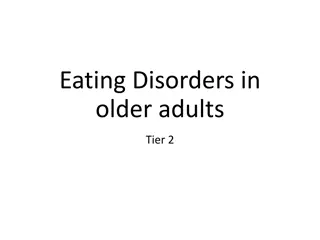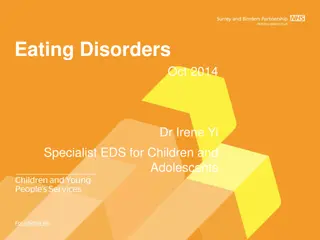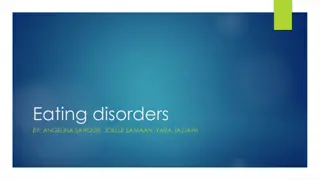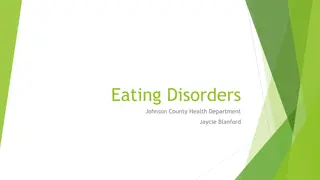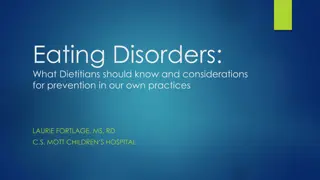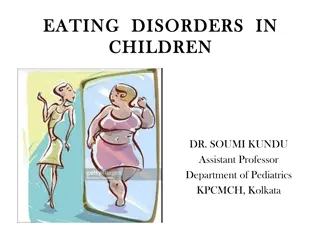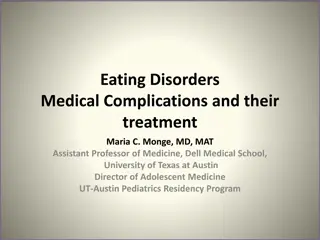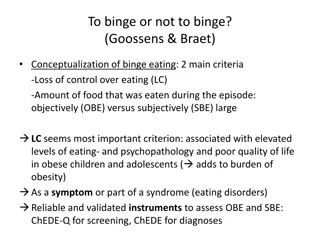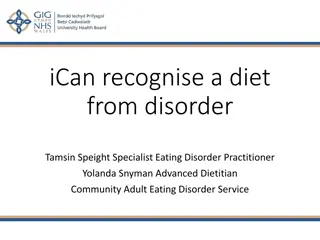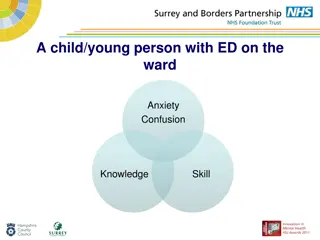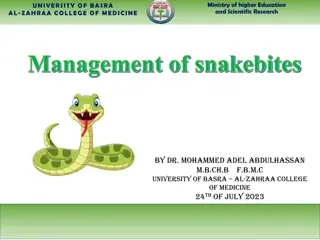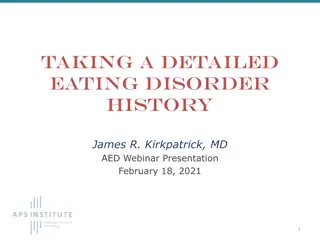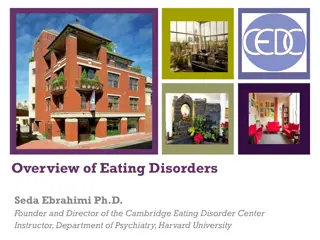Understanding Eating Disorders: An Overview from University of Basra College of Nursing
Eating disorders have a long history, with anorexia nervosa established as a mental disorder in the 1960s and bulimia nervosa described later. These disorders can be viewed on a continuum, with anorexia, bulimia, and obesity at different ends. Anorexia nervosa is characterized by restrictive behaviors, intense fear of gaining weight, and distorted body image. Clients can be classified based on weight control methods, either restrictive or involving binge eating and purging.
Download Presentation

Please find below an Image/Link to download the presentation.
The content on the website is provided AS IS for your information and personal use only. It may not be sold, licensed, or shared on other websites without obtaining consent from the author. Download presentation by click this link. If you encounter any issues during the download, it is possible that the publisher has removed the file from their server.
E N D
Presentation Transcript
University of Basra College of Nursing + Psychiatric Mental Health Nursing Psychiatric Mental Health Nursing EATING Disorder
OVERVIEW OF EATING DISORDERS + Although many believe that eating disorders are relatively new, documentation from the Middle Ages indicates willful dieting leading to self starvation in female saints who fasted to achieve purity. In the late 1800s, doctors in England and France described young women who used selfstarvation to avoid obesity. It was not until the 1960s, however, that anorexia nervosa was established as a mental disorder. Bulimia nervosa was first described as a distinct syndrome in 1979.
Eating disorders can be viewed on a continuum, with clients with + anorexia eating too little or starving themselves, clients with bulimia eating chaotically, and clients with obesity eating too much The distinguishing features of anorexia include an earlier age at onset and below-normal body weight; the person fails to recognize the eating behavior as a problem. Clients with bulimia have a later age at onset and near-normal body weight. They are usually ashamed and embarrassed by the eating behavior. More than 90% of cases of anorexia nervosa and bulimia occur in women. Although fewer men than women suffer from eating disorders, the number of men with anorexia or bulimia may be much higher than previously believed, many of whom are athletes
+CATEGORIES OF EATING DISORDERS First : Anorexia nervosa Anorexia nervosa is a life-threatening eating disorder characterized by the client s restriction of nutritional intake necessary to maintain a minimally normal body weight, intense fear of gaining weight or becoming fat, significantly disturbed perception of the shape or size of the body, and steadfast inability or refusal to acknowledge the seriousness of the problem or even that one exists. Clients with anorexia have a body weight that is less than the minimum expected weight considering age, height, and overall physical health.
Clients with anorexia nervosa can be classified into two subgroups + depending on how they control their weight: First : Clients with the restricting subtype lose weight primarily through dieting, fasting, or excessive exercising. Second : Those with the binge eating and purging subtype engage regularly in binge eating followed by purging. Binge eating means consuming a large amount of food (far greater than most people eat at one time) in a discrete period of usually 2 hours or less. Purging involves compensatory behaviors designed to eliminate food by means of self-induced vomiting or misuse of laxatives, enemas, and diuretics. Some clients with anorexia do not binge but still engage in purging behaviors after ingesting small amounts of food.
+ Clients with anorexia are often preoccupied with food-related activities, such as grocery shopping, collecting recipes or cookbooks, counting calories, creating fat-free meals, and cooking family meals. They may also engage in unusual or ritualistic food behaviors such as refusing to eat around others, cutting food into minute pieces, or not allowing the food they eat to touch their lips. These behaviors increase their sense of control. Excessive exercise is common; it may occupy several hours a day.
+ Bulimia nervosa, often simply called bulimia, is an eating disorder characterized by recurrent episodes of binge eating followed by inappropriate compensatory behaviors to avoid weight gain, such as purging, fasting, or excessively exercising. The amount of food consumed during a binge episode is much larger than a person would normally eat. The client often engages in binge eating secretly. Between binges, the client may eat low-calorie foods or fast. Binging or purging episodes are often precipitated by strong emotions and followed by guilt, remorse, shame, or self-contempt.
+ The weight of clients with bulimia is usually in the normal range, though some clients are overweight or underweight. Recurrent vomiting destroys tooth enamel, and incidence of dental caries and ragged or chipped teeth increases in these clients. Dentists are often the first health care professionals to identify clients with bulimia.
+Related Disorders to Eating Disorders First : Binge eating disorder is characterized by recurrent episodes of binge eating; no regular use of inappropriate compensatory behaviors, such as purging or excessive exercise or abuse of laxatives; guilt, shame, and disgust about eating behaviors; and marked psychological distress. Binge eating disorder frequently affects people over age 35, and it occurs more often in men than does any other eating disorder. Individuals are more likely to be overweight or obese, overweight as children, and teased about their weight at an early age
Second: Night eating syndrome is characterized by morning anorexia, + evening hyperphagia (consuming 50% of daily calories after the last evening meal), and nighttime awakenings (at least once a night) to consume snacks. It is associated with life stress, low self-esteem, anxiety, depression, and adverse reactions to weight loss . Most people with night eating syndrome are obese. Third :Eating or feeding disorders in childhood include pica, which is persistent ingestion of nonfood substances, and rumination, or repeated regurgitation of food that is then rechewed, reswallowed, or spit out. Both of these disorders are more common in persons with intellectual disability.
+ Fourth: Orthorexia nervosa, sometimes called orthorexia, is an obsession with proper or healthful eating. Behaviors include A. compulsive checking of ingredients; B. cutting out increasing number of food groups C. inability to eat only healthy or pure foods D. unusual interest in what others eat E. hours spent thinking about food, what will be served at an event F. obsessive involvement in food blogs
+ ETIOLOGY A specific cause for eating disorders is unknown. Initially, dieting may be the stimulus that leads to their development. Biologic vulnerability, developmental problems, and family and social influences can turn dieting into an eating disorder
+1. Biologic Factors Studies of anorexia nervosa and bulimia nervosa have shown that these disorders tend to run in families. Genetic vulnerability might also result from a particular personality type or a general susceptibility to psychiatric disorders Dysfunction of the hypothalamus. A family history of mood or anxiety disorders (e.g., obsessive compulsive disorder) places a person at risk for an eating disorder. Norepinephrine levels rise normally in response to eating, allowing the body to metabolize and use nutrients. Norepinephrine levels do not rise during starvation, however, because few nutrients are available to metabolize Increased levels of the neurotransmitter serotonin and its precursor tryptophan have been linked with increased satiety(satisfaction of appetite). Low levels of serotonin as well as low platelet levels of monoamine oxidase have been found in clients with bulimia and the binge and purge subtype of anorexia nervosa
+2.Developmental Factors Two essential tasks of adolescence are the struggle to develop autonomy and the establishment of a unique identity. Autonomy, or exerting control over oneself and the environment, may be difficult in families that are overprotective or in which enmeshment (lack of clear role boundaries) exists. Body image is how a person perceives his or her body, that is, a mental self-image. Body image disturbance occurs when there is an extreme discrepancy between one s body image and the perceptions of others and extreme dissatisfaction with one s body image
+ 3. Family Influences Girls growing up amid family problems and abuse are at higher risk for both anorexia and bulimia. Disordered eating is a common response to family discord. Girls growing up in families without emotional support may try to escape their negative emotions Childhood adversity has been identified as a significant risk factor in the development of problems with eating or weight in adolescence or early adulthood. Adversity is defined as physical neglect, sexual abuse, or parental maltreatment that includes little care, affection, and empathy as well as excessive paternal control, unfriendliness, or overprotectiveness.
+4. Sociocultural Factors the media fuels the image of the ideal woman as thin. This culture equates beauty, desirability, and, ultimately, happiness with being thin, toned, and physically fit. Adolescents often idealize actresses and models as having the perfect look or body, Western culture considers being overweight a sign of laziness, lack of self- control, or indifference; it equates pursuit of the perfect body with beauty, desirability, success, and willpower. Pressure from others may also contribute to eating disorders. Pressure from coaches, parents, and peers and the emphasis placed on body form in sports such as gymnastics, ballet, and wrestling can promote eating disorders in athletes
+ANOREXIA NERVOSA Onset and Clinical Course Anorexia nervosa typically begins between the ages of 14 and 18 years. In the early stages, clients often deny having a negative body image or anxiety regarding their appearance. They are pleased with their ability to control their weight and may express this. When they initially come for treatment, they may be unable to identify or to explain their emotions about life events such as school or relationships with family or friends. A profound sense of emptiness is common. As the illness progresses, depression and lability in mood become more apparent. As dieting and compulsive behaviors increase, clients isolate themselves. This social isolation can lead to a basic mistrust of others and even paranoia.
Clients may believe their peers are jealous of their weight loss and may + believe that family and health care professionals are trying to make them fat and ugly. For clients with anorexia, about 30% to 50% achieve full recovery, while 10% to 20% remain chronically ill. Compared to the general population, clients with anorexia are six times more likely to die from medical complications or suicide. Clients with the lowest body weights and longest durations of illness tended to relapse most often and have the poorest outcomes. Clients who abuse laxatives are at a higher risk for medical complications.
+Treatment and Prognosis Clients with anorexia nervosa can be difficult to treat because they are often resistant, appear uninterested, and deny their problems. Treatment settings include inpatient specialty eating disorder units, partial hospitalization or day treatment programs, and outpatient therapy. The choice of setting depends on the severity of the illness, such as weight loss, physical symptoms, duration of binging and purging, drive for thinness, body dissatisfaction, and comorbid psychiatric conditions
Medical Management + Medical management focuses on weight restoration, nutritional rehabilitation, rehydration, and imbalances. correction of electrolyte Psychopharmacology Several classes of drugs have been studied, but few have shown clinical success. Amitriptyline (Elavil) and the antihistamine cyproheptadine (Periactin) in high doses (up to 28 mg/day) can promote weight gain in inpatients with anorexia nervosa. Olanzapine (Zyprexa) has been used with success because of its antipsychotic effect (on bizarre body image distortions) and associated weight gain. Fluoxetine (Prozac) has some effectiveness in preventing relapse in clients whose weight has been partially or completely restored
Psychotherapy + Family therapy may be beneficial for families of clients younger than 18 years Family therapy is also useful to help members be effective participants in the client s treatment. Family-based early intervention can prevent future exacerbation of anorexia when families are able to participate in an effective manner Individual therapy for clients with anorexia nervosa may be indicated in some circumstances; for example, if the family cannot participate in family therapy, if the client is older or separated from the nuclear family, or if the client has individual issues requiring psychotherapy. CBT, long used with clients with bulimia, has been adapted for adolescents with anorexia nervosa and used successfully for initial treatment as well as relapse prevention. Enhanced cognitive behavioral therapy (CBT-E) has been even more successful than CBT. In addition to addressing the body image disturbance and dissatisfaction, CBT-E addresses perfectionism, mood intolerance, low selfesteem, and interpersonal difficulties
+BULIMIA NERVOSA Onset and Clinical Course Bulimia nervosa usually begins in late adolescence or early adulthood; 18 or 19 years is the typical age of onset. Binge eating frequently begins during or after dieting. Between binging and purging episodes, clients may eat restrictively, choosing salads and other low-calorie foods. This restrictive eating effectively sets them up for the next episode of binging and purging, and the cycle continues. Clients with bulimia are aware that their eating behavior is pathologic, and they go to great lengths to hide it from others. They may store food in their cars, desks, or secret locations around the house.
Follow-up studies of clients with bulimia show that as many as 25% or more are + untreated. Clients with bulimia had 45% full recovery, while 23% remained chronically ill. One-third of fully recovered clients relapse. Clients with a comorbid personality disorder tend to have poorer outcomes than those without. The death rate from bulimia is estimated at 3% or less. Most clients with bulimia are treated on an outpatient basis. Hospital admission is indicated if binging and purging behaviors are out of control and the client s medical status is compromised. Most clients with bulimia have near-normal weight, which reduces the concern about severe malnutrition, a factor in clients with anorexia nervosa.
+Treatment and Prognosis Cognitive Behavioral Therapy CBT has been found to be the most effective treatment for bulimia. Thisoutpatient approach often requires a detailed manual to guide treatment. Psychopharmacology antidepressants, to treat bulimia. Drugs, such as desipramine (Norpramin), imipramine (Tofranil), amitriptyline (Elavil), nortriptyline (Pamelor), phenelzine (Nardil), and fluoxetine (Prozac), were prescribed in the same dosages used to treat depression
+Nursing diagnoses for clients with eating disorders Imbalanced nutrition: Less than/more than body requirements Ineffective coping Disturbed body image Chronic low self-esteem Other nursing diagnoses may be pertinent, such as deficient fluid volume, constipation, fatigue, and activity intolerance.


